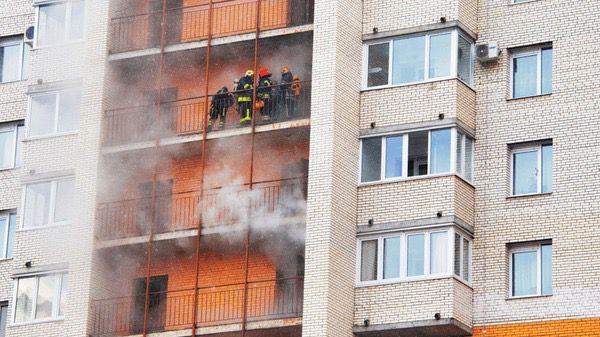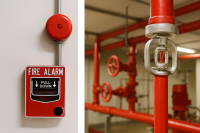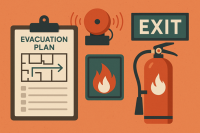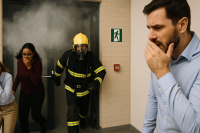
High-rise buildings are marvels of modern engineering, transforming urban skylines around the world. However, the towering nature of these structures presents unique fire safety challenges. Ensuring the safety of occupants in high-rise buildings during a fire requires meticulous planning, advanced technology, and stringent regulations. In this article, we will explore the specific challenges of fire safety in tall buildings and the solutions that can be implemented to mitigate risks.
Challenges of Fire Safety in High-Rise Buildings
- Evacuation Difficulties
One of the most significant challenges in high-rise buildings is evacuating occupants during a fire. The higher the floor, the more difficult and time-consuming it becomes for people to reach safety, especially in the case of full-building evacuations. Stairs are often the only safe means of escape, but navigating dozens of floors can be physically challenging, particularly for the elderly, children, or those with disabilities. - Fire Spread and Vertical Propagation
Fires in high-rise buildings pose a unique risk of vertical propagation, where flames and smoke can quickly spread from one floor to another, particularly through exterior cladding, windows, and ventilation systems. The rapid spread of fire across multiple floors can complicate containment efforts and place more occupants at risk. - Limited Access for Firefighters
In the event of a fire in a high-rise building, firefighters face significant challenges in reaching the upper floors. While most fire trucks have ladders that can reach a limited number of floors, these tools are often insufficient for buildings that soar 20, 30, or more stories high. Firefighters must rely on internal systems, such as fire elevators or stairs, which can be dangerous and time-consuming during a fire emergency. - Complex Building Layouts
Modern high-rise buildings often feature complex layouts, including multiple zones, corridors, and open-plan spaces, which can hinder swift evacuation and make firefighting operations more difficult. A fire can spread unpredictably in such layouts, complicating both rescue efforts and suppression strategies. - Increased Occupancy Density
High-rise buildings, particularly those used as residential complexes or offices, house a large number of people in a relatively small footprint. This increased occupancy density means that more lives are at risk in the event of a fire, and evacuation becomes more difficult due to crowded exits and stairwells.
Solutions for Fire Safety in High-Rise Buildings
- Advanced Fire Detection and Alarm Systems
Early fire detection is critical in high-rise buildings to give occupants enough time to evacuate safely. Modern fire detection systems are integrated with advanced smoke and heat sensors that can detect fires in their early stages. Smart fire alarms can also be programmed to provide specific evacuation instructions for different floors or zones, preventing congestion in stairwells and exits.
Additionally, voice alarm systems can guide people to safety, providing real-time information on which exits to use or avoid based on the fire’s location. - Fire Sprinkler Systems
Automatic fire sprinkler systems are essential for fire suppression in high-rise buildings. In the event of a fire, sprinklers can help control or extinguish the flames before they spread to other floors. Installing sprinklers throughout a building, including in hallways, common areas, and individual units, significantly reduces the risk of a major fire.
In some high-rise buildings, additional systems such as water mist or gas suppression may be used to provide effective fire suppression in areas where water damage would be a concern, such as electrical rooms or data centers. - Fireproofing and Compartmentation
One of the most effective methods for preventing the spread of fire in high-rise buildings is through compartmentation. This involves dividing the building into separate fire-resistant zones using fire-rated walls, floors, and doors. Fireproofing materials and firestopping techniques around openings like doors, windows, and service shafts help contain the fire to its origin floor, reducing the likelihood of vertical propagation.
Fire-resistant cladding and windows are also important for preventing external fire spread, especially in the aftermath of high-profile building fires caused by flammable exterior materials. - Smoke Control Systems
Smoke is one of the greatest dangers in high-rise fires, as it can quickly spread through stairwells, elevators, and ventilation systems, making escape and firefighting efforts more difficult. Modern high-rise buildings are equipped with smoke control systems, such as pressurized stairwells and fire-rated smoke curtains, to limit smoke infiltration and keep escape routes clear.
Mechanical smoke exhaust systems are also installed in many high-rise buildings to extract smoke from key areas like corridors and lobbies, ensuring that these spaces remain usable during a fire emergency. - Firefighter Access and Elevators
Ensuring that firefighters can reach upper floors quickly and safely is critical in high-rise fire response. High-rise buildings are typically equipped with firefighter elevators, which are specially designed to operate even in the event of a fire. These elevators are reinforced with fireproofing and have a direct connection to a backup power supply, allowing firefighters to access high floors more easily.
In addition, buildings must have clearly marked firefighter access points and standpipe systems to allow for effective firefighting operations. - Emergency Evacuation Planning
Detailed emergency evacuation plans are vital for high-rise fire safety. These plans should account for factors like occupancy type, building layout, and potential evacuation bottlenecks. Regular fire drills are essential to ensure that occupants know how to respond during a fire and are familiar with evacuation routes.
For larger high-rise buildings, phased evacuation strategies can be implemented, where only the occupants on the fire floor and adjacent floors are evacuated immediately, while others are held in place until it is safe to leave. This helps prevent overcrowding in stairwells and reduces panic.
- Regulatory Compliance and Building Codes
Ensuring that high-rise buildings comply with local fire safety regulations and building codes is fundamental to effective fire protection. In Indonesia, for example, building developers must adhere to strict fire safety standards that dictate the use of fire-resistant materials, fire suppression systems, and evacuation plans.
Regular inspections by fire safety authorities are necessary to ensure that these systems remain in optimal working condition and that any potential hazards are addressed before they become life-threatening issues.
Conclusion
Fire safety in high-rise buildings presents unique challenges due to the height, occupancy density, and complexity of these structures. However, with advanced fire detection systems, robust fire suppression technologies, and well-planned evacuation strategies, these challenges can be effectively managed. By integrating modern solutions such as fire sprinklers, smoke control systems, and fireproofing, high-rise buildings can be made safer for occupants, ensuring that in the event of a fire, risks are minimized and lives are saved.





Leave A Comment